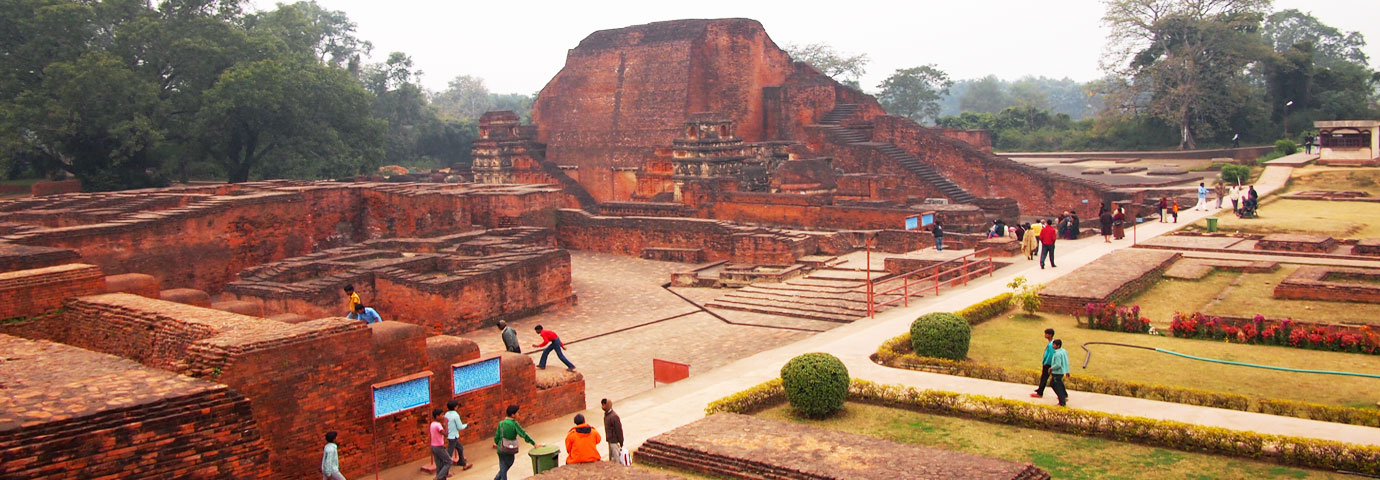Fast Facts
|
Language |
Hindi & English |
|
Best time to visit |
October to March |
Location
Nalanda, one of the greatest centers of learning in the ancient times, is located in the eastern Indian state of Bihar. A small village now, Nalanda is situated around 72 km off Patna, the capital of Bihar and is part of the Buddhist Circuit that also includes Bodh Gaya and Rajgir. The village has a good network of roads that connects it to the other cities of the state.
Best Time To Visit
Nalanda, being in the Gangatic plains, suffers from extreme weather conditions. The temperature during summer can reach a maximum of 37.8°C and a minimum of 17.8°C. The maximum temperature during winter remains at around 27.8°C while the minimum temperature dips down to as low as 10.6°C. Monsoon arrives in this region in June and continued till September. The average rainfall during monsoon is 120 cm.
History
Founded in the fifth century AD, Nalanda is well known as an ancient seat of learning. However, today this ancient university lies in ruins. The place not only has the remains of the great university but also many monasteries, temples, and viharas built by different kings.
Though the Buddha visited Nalanda several times during his lifetime, this famous centre of Buddhist learning shot to fame much later, during 5th-12th centuries AD. In this first residential international university of the world, 2,000 teachers and 10,000 students from all over the Buddhist world lived and studied.
The university found patrons in Gupta, Kushan, and Pal kings in successive centuries. Ashoka and Harshavardhana were some of its most celebrated patrons who built temples and monasteries here. Recent excavations have unearthed elaborate structures here. The university remained in prominence till 12 century AD when the Afghans attacked Bengal and burnt down this great University.
Tourists Attractions
The ruins of Nalanda University are spread over an area of 14 hectares of land. The university was constructed in the Kushana style of architecture, but the impact of the Pala dynasty is widely visible throughout. Past excavations suggest that a large part of the University is still unexcavated, but nowhere does it suggest that the whole site could have accommodated 10,000 students and 2,000 teachers.
The Hiuen Tsang Memorial Hall is said to have been built in the memory of Hiuen Tsang, a Chinese traveler who came to India in around 5th century AD. Hiuen Tsang was attracted by the glory of Nalanda University and stayed there for 12 years both as a student and as a teacher. He gave detailed and vivid description of the Indian political and social conditions of that time.
The Surya Mandir is a temple near the University dedicated to the Sun God. This temple has a number of statues of Hindu and Buddhist deities. A five feet high statue of Parvati is of particular interest.
The Nalanda museum was established in 1971 and has a good collection of ancient manuscripts and Buddhist statues. The manuscripts kept here were found during the excavation of the area and many of them are rare in appearance and style. The museum also displays artifacts of the Maurya, Gupta and other periods.
The Nav Nalanda Vihar was established in 1951 to keep the ancient tradition of spreading knowledge alive. The Bihar government has set up this institute that teaches Pali near the ancient university. In the institute Indian as well as foreign students study and do research work on Buddhism and Pali, which was a widely used language in the ancient times.
Places Around Nalanda
Rajgir is around 12 km from Nalanda and a famous pilgrimage center for Hindus, Buddhists, and Jains. There are many places of interest here such as the Swarna Gufa, Griddhakuta Parvat, and Vishwa Shanti Stupa etc.
Bihar Sharif, 13 km away is the district headquarters and a center of Islamic architecture. The tomb of Malik Ibrahim Baya is situated here and an annual Urs is celebrated.
Bodh Gaya, the most important Buddhist pilgrimage center is around 50 km away from Nalanda. There is the Maha Bodhi Temple, monasteries built by the governments of Buddhist countries, and an archeological museum along with several other sites.
Gaya is situated around 65 km from Nalanda and is a major pilgrimage center for Hindus.
Pawapuri is situated at a distance of 47 km from Nalanda and believed to be the place where Lord Mahavira died.
Patna, the capital of Bihar and a great historical city is situated around 72 km northeast of Nalanda.
Fairs & Festivals
Unique in Nalanda is the Chhath Puja, or worship of the Sun god. The most famous one is at the Sun temple in Baragaon near Nalanda, where new paddy, sweets, and fruits are offered in worship.
The Buddha was born, attained enlightenment and attained nirvana, all on the same full moon day of April/May. Thus, Baisakhi Purnima is celebrated as Buddha Jayanti here.
How To Reach
By Air - The nearest airport from Nalanda is Patna around 89 km away. There are regular flights from Patna connecting to Kolkata, Delhi, Ranchi, Mumbai, Varanasi, Lucknow, and Kathmandu.
By Rail - Rajgir 12 km away is the nearest railway station from Nalanda. nearest major railway point is Gaya around 65 km away, from where one can take trains for Delhi, Kolkata, Varanasi, and some of the major centers in eastern India.
By Road - Nalanda is connected through a good road network with Rajgir 12 km, Bodh Gaya 50 km, Gaya 65 km, Patna 90 km, Pawapuri 26 km, and Bihar Sharif 13 km.


